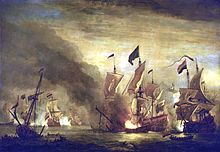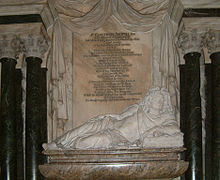- Cloudesley Shovell
-
Sir Cloudesley Shovell 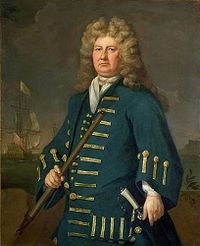
Sir Cloudesley Shovell, (1650–1707). Oil by Michael DahlBorn November 1650 Died 22 October or 23 October 1707
Off the coast of Scilly IslesBuried at St Mary's, Isles of Scilly later moved to Westminster Abbey Allegiance  Great Britain
Great BritainService/branch  Royal Navy
Royal NavyRank Admiral of the Fleet Commands held
Commander-in-Chief of the British fleets
HMS Sapphire
HMS Edgar
HMS PrinceBattles/wars - Third Anglo-Dutch War
- Battle of Sole Bay
- Battle of Texel
- Nine Years' War
- Battle of Bantry Bay
- Battle of Beachy Head (1690)
- Battle of Cape Barfleur
- War of the Spanish Succession
- Capture of Gibraltar
- Siege of Barcelona (1705)
- Battle of Toulon (1707)
Other work Commissioner of the Sewers Admiral of the Fleet Sir Cloudesley Shovell (c. November 1650 – 22 October or 23 October 1707), was an English naval officer. Rising through the ranks and fighting in many of the important battles of the late 17th and early 18th centuries, he became a popular British hero,[1] whose celebrated career was brought to an end in a disastrous shipwreck in the Isles of Scilly. He also served as MP for Rochester from 1695 until his death.
Contents
Origin and family
The unusual Christian name of Cloudesley was the surname of his maternal grandmother Lucy Cloudisley, who was the daughter of Thomas Cloudisley. His father, John Shovel, a gentleman, was descended from a family who had property and standing in Norwich and his mother was descended from local gentry. Although not poor, the Shovells were by no means wealthy.[2]
In 1653, when Cloudesley was three, his father died. He left £100 to each of his three sons, Nathaniel, Thomas and Cloudesley. Cloudesley's widowed mother, Anne Jenkinson, remarried John Flaxman. In 1691 Cloudesley Shovell married Elizabeth, Lady Narborough (née Hill), the widow of his former commander, Rear Admiral Sir John Narborough.[3] Through her, he had two stepsons Sir John Narborough, 1st Baronet, and James Narborough) who both entered naval careers and died, aged 23 and 22, in the sinking of HMS Association in 1707.[4] Shovell and his wife had two daughters: Elizabeth and Anne. Elizabeth married first the 1st Baron Romney whilst Anne married John Blackwood.[5] Elizabeth Shovell, the former Lady Narborough, is buried in St Paulinus Church, Crayford, where there is a memorial to her and her husband. Cloudesley Shovell is also mentioned on the memorial to his Narborough stepsons in Knowlton Church. Their memorial displays a rendition of the grounding of HMS Association.[3]
Spelling of his name
There are many different versions used for the spelling of both his Christian name and surname. He used the spelling Cloudesley Shovell in his will written on 20 April 1701 when he was fifty. Both his father and his widow also spelt their surname as Shovell in their wills. The Christian name Cloudesley was often indistinctly signed which may have given rise to variety of spellings used by subsequent biographers. Nonetheless, spellings such as Cloudisley and Shovel are occasionally seen in books and articles on him.
Life and career
Early life
Shovell was baptised at Cockthorpe in Norfolk, in 1650. He first went to sea as a cabin boy under the care of a relative on his father’s side, Admiral Sir Christopher Myngs. Through family connections he joined the Royal Navy as a cabin boy in 1664.[3]
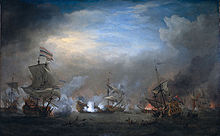 Battle of Texel, 21 August 1673.
Battle of Texel, 21 August 1673.
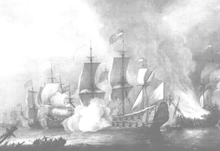 Battle of Bantry Bay, 11 May 1689.
Battle of Bantry Bay, 11 May 1689.
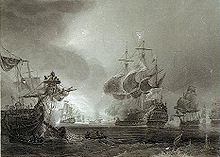 Battle of Beachy Head, 10 July 1690.
Battle of Beachy Head, 10 July 1690.
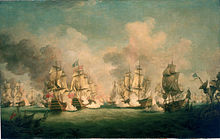 Battle of Cape Barfleur, 19 May 1692.
Battle of Cape Barfleur, 19 May 1692.
Early in his career he went on voyages to the West Indies and South America and on 22 January 1672 he became Midshipman on the HMS Royal Prince and saw action at the Battle of Sole Bay off the Suffolk coast on 28 May when a combined British and French fleet were surprised and attacked by the Dutch, led by Admiral Michiel de Ruyter. Later in 1672 Shovell was promoted to Master's Mate aboard HMS Fairfax, then later the HMS Harwich and finally the HMS Henrietta. On 21 August 1673, he again saw action, this time at the Battle of Texel. A combined British and French fleet attempting to land troops in the Netherlands was repelled by a smaller Dutch force, again led by Admiral de Ruyter.[3]
After Admiral Sir Christopher Myngs died from wounds received during the Second Dutch War, Shovell’s career continued through the influence of another distant relation, Sir John Narborough.[2] Shovell set himself to study navigation, and, owing to his able seamanship and brave and open-hearted disposition, became a general favourite and obtained quick promotion. On 25 September 1673 he was promoted to the rank of Second Lieutenant aboard the Henrietta and sailed to North Africa. In the Mediterranean he served under Narborough against the Barbary pirates. In 1675 he transferred to the Harwich and took part in a year long action against the pirate stronghold at Tripoli. On 14 January 1676, Shovell lead a surprise attack on the pirates sinking a number of their ships. For this action he received the sum of £ 80 from his commanding officer Sir John Narborough. Two months later a second successful raid against the pirates was undertaken, for which Shovell was awarded a gold medal from King Charles II himself,[3] and in a letter from the Admiralty, Samuel Pepys recorded the king's satisfaction with Shovell’s actions.[2] This was the beginning of his rise to prominence. On 16 April 1677 Shovell was again promoted to First Lieutenant aboard HMS Plymouth and just six months later he received his first command as captain of HMS Sapphire. He spent the next nine years in command of various ships in the Mediterranean carrying out operations against the Barbary pirates.[3]
In May 1689 Shovell served in the Nine Years' War under Admiral Herbert. As captain of HMS Edgar he was present at the first fight of the Battle of Bantry Bay when a French fleet was landing troops against King William III. After the battle, Shovell and his fellow commander John Ashby were knighted by the king.[3] In October, he patrolled the area between Ireland and the Scilly Islands.[2] In 1690 Sir Cloudesley convoyed William III across St George's Channel to Ireland, was promoted Rear Admiral of the Blue and fought in the Battle of Beachy Head. In 1691 he married Lady Elizabeth Narborough, the widow of his former commanding officer. In 1692 he was appointed Rear Admiral of the Red and took part in the Battle of Cape Barfleur in May. He joined Admiral Russell under whom he greatly distinguished himself at La Hougue, by being the first to break through the enemy's line aboard HMS Prince. During this action at Barfleur, Shovell was injured in the thigh and suffered from blood poisoning but was able to recuperate back in England.[3] Not long after, when Admiral Russell was superseded, Shovell was put in joint command of the fleet with Admiral Killigrew[6] and Admiral Delaval. In 1693 and 1694 he was involved in further actions against the French in the English Channel. In 1696 he was promoted to Admiral of the Blue and in 1702 Admiral of the White by Queen Anne. Sir Cloudesley was a particular favourite of the Queen.[3]
Politician and benefactor
In 1694 Shovell set up residence with his wife at May Place in Crayford, Kent, and in 1695 was elected Member of Parliament for Rochester.[7] In Crayford he was responsible for the restoration of the parish church, St. Paulinus.[5] Shovell served as MP for Rochester until his death. During that time he was a great benefactor to the city, providing at his own expense the fine decorated plaster ceilings in the Guildhall and the market bell, clock and decorated brick facade for the Butchers' Market, (now the Corn Exchange). All these gifts survive, except the clock which, by 1771, had deteriorated so badly that a replacement was installed by Rochester Corporation. Shovell was also Commissioner of the Sewers, responsible for the upkeep of the embankments of the Thames between Deptford and Gravesend.[5]
Commander-in-Chief of the British fleets
In 1702 Shovell brought home the spoils of the French and Spanish fleets from Vigo after their capture by Admiral Rooke, and in January 1704 he was named Rear-Admiral of England. Later that year he served under Admiral Rooke in the Mediterranean and cooperated in the taking of Gibraltar. On 13 January 1705 Shovell became Admiral of the Fleet and on 1 May the same year he was given joint command with the 3rd Earl of Peterborough of an expeditionary force to the Mediterranean, during which Spanish port of Barcelona was besieged and captured. In November 1706 his career reached its peak when he was appointed Commander-in-Chief of the British fleets whilst at Lisbon.[3] In summer of 1707 he commanded the naval part of the unsuccessful Battle of Toulon. During the War of the Spanish Succession, a combined British, Austrian and Dutch force under the command of Prince Eugene besieged and attempted to take the French port of Toulon. During this campaign, which was fought from 29 July to 21 August, Great Britain dispatched a fleet to provide naval support. Led by Shovell, the ships sailed to the Mediterranean, attacked Toulon and also managed to inflict damage on the French fleet caught in the siege. The campaign was unsuccessful though and the alliance ultimately defeated by Franco-Spanish units. The British fleet was subsequently ordered to return home, and set sail from Gibraltar to Portsmouth in late October.
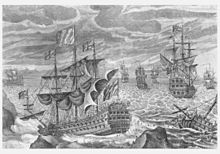 An 18th century engraving of the disaster, with HMS Association in the centre
An 18th century engraving of the disaster, with HMS Association in the centre
 Memorial at Porthellick Cove where Shovell's body was washed ashore
Memorial at Porthellick Cove where Shovell's body was washed ashore
When returning with the fleet to England after the campaign to Toulon, Shovell's ship, HMS Association, at 8 pm on 22 October (November 2, by the modern calendar) 1707, struck on the rocks near the Isles of Scilly along with several other ships, and was seen by those on board HMS St George to go down in three or four minutes' time, not a soul being saved of 800 men that were on board. With four large ships (HMS Association, HMS Eagle, HMS Romney and HMS Firebrand) and nearly 2,000[8] sailors lost that night, the Scilly naval disaster was one of the greatest maritime disasters in British history. It was later determined that the main cause of the disaster was the navigators' inability to accurately calculate their longitude.[9]
What exactly happened to Sir Cloudesley Shovell has never been discovered. The most likely outcome, considering that his body was found almost seven miles from where his ship was wrecked, suggests that Shovell left his ship in one of its boats, along with his two Narborough stepsons, the captain of the Association, Loades, and a pet dog and that they were drowned while trying to get to shore.[2] Shovell's body, along with the bodies of his two stepsons and that of Captain Loades, washed up on Porthellick Cove on St Mary's the following day. A small memorial was later erected at this site. Shovell's body was identified by the Purser of HMS Arundel who knew the admiral well. It was identified by "a black mole under his left ear, also by the first joint of one of his forefingers being broken inwards. He had likewise a shot in his right arm, another in his left thigh".[3] The circumstances under which the his remains were found gave rise to stories (see below). Shovell was temporarily buried on the beach at Porthellick Cove (see image).[10] By order of Queen Anne the body was later exhumed and brought back aboard HMS Salisbury to Plymouth, where it was embalmed by Dr James Yonge. It was later carried in state to London. During the journey from the West Country, large crowds turned out to pay their respects. On 22 December 1707 he was interred in Westminster Abbey.[3] His large marble monument in the south choir aisle was sculpted by Grinling Gibbons.[11] His two stepsons were buried in Old Town Church on St Mary’s.[2] The Council of the Scilly Isles commemorated the tercentenary of the disaster in 2007.[12]
Legends of the disaster
It is said that Shovell was alive, at least barely, when he reached the shore of Scilly at Porthellick Cove, but was murdered by a woman for the sake of his priceless emerald ring which had been given to him by a close friend, Captain James Lord Dursley. At that time, the Scillies had a wild and lawless reputation.[3] According to a letter written in 1709 by Edmund Herbert, a young man sent to Scilly by Shovell's family to help locate and recover items belonging to the admiral, Sir Cloudesley's body was first found by two women "stript of his shirt" and " his ring was also lost off his hand, which however left ye impression on his finger". Shovell's widow Elizabeth had offered a large reward for the recovery of any family property.[3] It is claimed that the murder only came to light some thirty years later when the woman, on her deathbed, confessed to a clergyman to having killed the admiral and produced the stolen ring,[13] which was sent back to the 3rd Earl of Berkeley.[2]
It is also said that a common sailor on his ship tried to warn them that they were off course, either because he was a native of the Scilly Isles and knew a distinct smell of the land or he had been keeping his own log (which is a variant appearing in the late 19th century), but Shovell had him hanged at the yardarm for inciting mutiny.[13] While it is not at all unlikely that a sailor might have debated the vessel's location and feared for its fate (such debates were common upon entering the English Channel as noted by Samuel Pepys in 1684), there is no evidence that the man was hanged in contemporary documents. Regardless, assuming this sailor did exist and was not hanged, he was equally dead by drowning with the rest of the crew of the Association a few hours later.
In fiction
Shovell was portrayed by English actor Jonathan Coy in the 2000 television movie Longitude. He is also referred to in Patrick O'Brian's novel "Blue at the Mizzen" in which Mr Woodbine recalls running for the Scillies under full topsails with the wind and hoping not to run on to the reef "like Sir Cloudesley Shovell".
In Robert Goddard's novel Name to a Face,[14] the recovery of the ring Shovell was wearing when the Association sank is central to the plot.
A Halifax tavern named for Shovell appears in Paul Marlowe's Knights of the Sea.
References
- ^ Nicholls, Mark, Norfolk Maritime Heroes and Legends, Poppyland Publishing, Cromer 2008, p. 25-30, ISBN 976-0-9461-4885-1
- ^ a b c d e f g h i j k l m n "The legacy of Sir Cloudsley Shovel". www.kenthistoryforum.co.uk. http://www.kenthistoryforum.co.uk/index.php?topic=2623.0. Retrieved 2010-02-06.
- ^ Herbert, James (2005-05-17). "James Herbert Cooke, The Shipwreck of Sir Cloudesley Shovell on the Scilly Islands in 1707, From Original and Contemporary Documents Hitherto Unpublished, Read at a Meeting of the Society of Antiquaries, London, Feb. 1, 1883". Hmssurprise.org. http://www.hmssurprise.org/Resources/SIR_CLOUDESLEY_SHOVELL.html. Retrieved 2010-02-06.
- ^ a b c Thomas, E.O., Slade Green and the Crayford Marshes, Bexley Education and Leisure Services Directorate, 2001, ISBN 0902 541 552
- ^ ODNB identifies this Admiral as Henry Killigrew (c.1652–1712), not his brother Admiral James Killigrew (died 1695) in the article on Henry Killigrew by J. K. Laughton, revised J. D. Davies [1] accessed 14 May 2007.
- ^ Leigh Rayment's Historical List of MPs – Constituencies beginning with "R" (part 2)
- ^ Sobel, Dava, Longitude: The True Story of a Lone Genius Who Solved the Greatest Scientific Problem of His Time, Fourth Estate Ltd., London 1998, p. 6, ISBN 1-85702-571-7
- ^ For more detail on the wreck and its salvage in the 20th century, see McBride, Peter and Larn, Richard (1999) Admiral Shovell's treasure; ISBN 0-9523971-3-7 (hardback) ISBN 0-9523971-2-9 (paperback). This includes much detailed information, such as a Shovell family tree.
- ^ A photograph by Frank W.Gibson of Admiral Shovell's temporary grave in Porthellick Cove.
- ^ "Sir Clowdisley Shovell's tomb and memorial in Westminster Abbey". http://www.westminster-abbey.org/our-history/people/sir-clowdisley-shovell. Retrieved 2010-01-29.
- ^ "Council of the Scilly Isles website". Scilly.gov.uk. http://www.scilly.gov.uk/search/default.htm?q=shovell&order=R. Retrieved 2010-02-06.
- ^ a b Sobel, Dava, Longitude: The True Story of a Lone Genius Who Solved the Greatest Scientific Problem of His Time, Fourth Estate Ltd., London 1998, p. 11-16, ISBN 1-85702-571-7
- ^ (2007) ISBN 978-0-593-05367-6
 This article incorporates text from a publication now in the public domain: Chisholm, Hugh, ed (1911). Encyclopædia Britannica (11th ed.). Cambridge University Press.
This article incorporates text from a publication now in the public domain: Chisholm, Hugh, ed (1911). Encyclopædia Britannica (11th ed.). Cambridge University Press.- Life and Glorious Actions of Sir Cloudesley Shovl (1707); Burnet's Own Times; various discussions in Notes and Queries, 5th series, vols. x. and xi.; and TH Cooke, Shipwreck of Sir Cloudesley Shovel (1883).
- Memoirs of Sir Cloudesley Shovel, Knt. Rear-Admiral of England, Etc. From Lives of the Admirals by John Campbell, Publ. 1744. public domain transcript
- The murder of a naval hero, Memories page, Medway News, by Stephen Rayner, 9 September 2005.
- Sir Cloudesley Shovell: Stuart Admiral, by Simon Harris, Spellmount 2000. ISBN 1-86227-099-6
- John B. Hattendorf, "Sir George Rooke and Sir Cloudesley Shovell" in Peter Le Fevre and Richard Harding, eds. Precursors of Nelson: British admirals of the eighteenth century. London: Chatham, 2000.
External links
- "A Biographical Memoir of Sir Cloudesly Shovel" — Originally printed in the March 1815 issue of The Naval Chronicle
- 'Shovell, Sir Cloudesley (bap. 1650, d. 1707)' — Oxford Dictionary of National Biography article by John B. Hattendorf (Oxford University Press, 2004)
Military offices Preceded by
Sir George RookeAdmiral of the Fleet
1705–1708Succeeded by
Sir Stafford FairborneCategories:- Maritime incidents in 1707
- Royal Navy admirals
- British naval commanders in the War of the Spanish Succession
- Members of the pre-1707 Parliament of England
- Burials at Westminster Abbey
- Deaths due to shipwreck
- 1650 births
- 1707 deaths
- People from North Norfolk (district)
- Third Anglo-Dutch War
Wikimedia Foundation. 2010.

